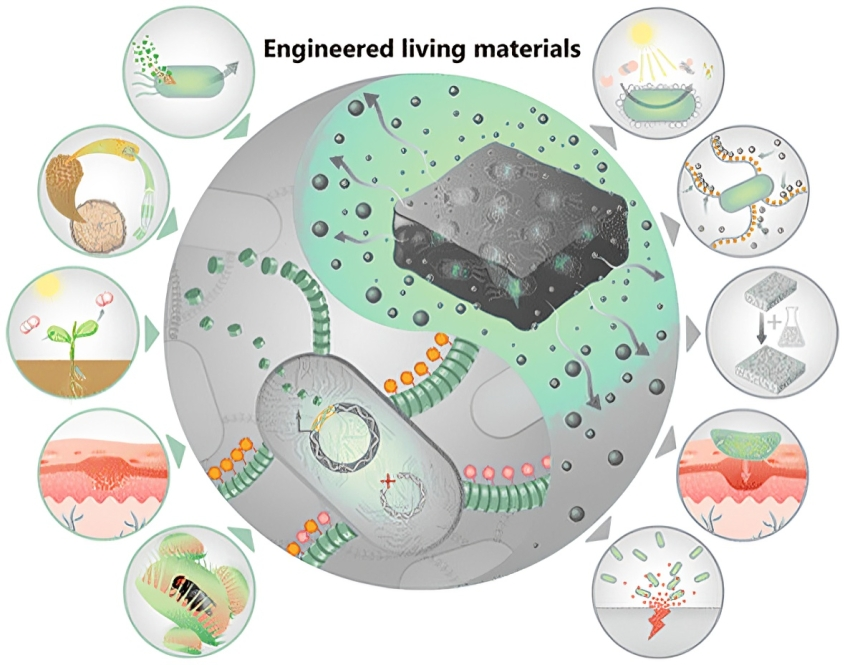Living Materials: All You Need to Know
Dive into the fascinating world of living materials, where biology meets materials science in a revolutionary fusion. Explore the dynamic nature of these materials, incorporating living organisms to unlock unprecedented possibilities. From their origins in biomimicry to the latest breakthroughs, this article unveils the exciting journey and potential applications of living materials. Let’s dive deep and explore how living materials could reshape industries and pave the way for a more sustainable world.

What are Living Materials?
Living materials, or biohybrid or biologically integrated materials, are a distinct class of materials that incorporate living organisms or components derived from living organisms. Unlike traditional materials, which are typically inert, living materials can respond, adapt, and even grow in response to external stimuli. These materials can encompass various biological entities, from cells and bacteria to fungi and algae.
Evolution of Living Materials in Materials Science
The evolution of living materials in materials science reflects a progressive shift from conventional static materials to dynamic, responsive systems. The inception of this field can be traced back to the exploration of biomimicry, where scientists sought inspiration from nature to develop materials with enhanced properties. However, the integration of living organisms into materials is a more recent and revolutionary development.
Researchers and scientists have increasingly recognized the potential of living materials to overcome some of the limitations associated with traditional materials. Evolution involves harnessing the capabilities of living organisms to impart functionalities such as self-repair, adaptability to changing environments, and the ability to perform complex tasks. This transition has been facilitated by advancements in genetic engineering, synthetic biology, and materials science, enabling the controlled design and manipulation of biological components within materials.
The Concept of Living Materials
Living materials represent a transformative paradigm in materials science, introducing a dynamic interplay between biological entities and structural compositions. Let’s explore the core concepts that define living materials, exploring the incorporation of living organisms into structures, the ingenious self-healing mechanisms they exhibit, and their adaptive and responsive nature.
A. Incorporating Living Organisms into Structures
At the heart of living materials lies the innovative integration of living organisms into traditional structural frameworks. This integration can take various forms, from embedding cells and bacteria within a material matrix to fostering symbiotic relationships between biological components and synthetic substrates. The result is a novel class of materials that not only possess the inherent properties of their constituent elements but also gain the remarkable ability to interact, grow, and evolve.
B. Self-Healing Mechanisms in Living Materials
One of the standout features of living materials is their intrinsic self-healing capability. Inspired by nature’s regenerative processes, these materials can autonomously repair damage inflicted upon them. Whether it’s microcracks in a structural element or wear and tear over time, living materials employ biological mechanisms that enable them to mend and rejuvenate. This self-healing property not only extends the lifespan of materials but also holds promise for applications in industries ranging from construction to biomedical engineering.
C. Adaptive and Responsive Nature of Living Materials
Living materials exhibit an unparalleled adaptive and responsive nature, setting them apart from their conventional counterparts. Through the incorporation of living organisms, these materials can sense changes in their environment and adjust their properties accordingly. This responsiveness allows living materials to thrive in dynamic conditions, making them ideal candidates for applications where adaptability is crucial. From smart textiles that respond to temperature changes to building materials that adapt to structural stresses, the adaptive nature of living materials opens up a realm of possibilities for technological innovation.
Challenges in Developing Living Materials
While the potential of living materials is vast and promising, their development comes with challenges that researchers and scientists must navigate.
A. Stability and Longevity of Living Components
A central challenge in the development of living materials lies in ensuring the stability and longevity of the incorporated living components. Living organisms are inherently sensitive to environmental changes, and their viability within a material matrix is subject to various factors. Researchers must grapple with optimizing conditions to sustain the vitality of living components over extended periods, ensuring that the materials remain functional and effective throughout their intended lifespan. Achieving this delicate balance is crucial for realizing the practical applications of living materials in diverse fields.
B. Ethical Considerations
Integrating living organisms into materials raises profound ethical considerations that demand scrutiny. As researchers push the boundaries of biohybrid materials, questions surrounding the ethical treatment of living entities, potential ecological impacts, and unintended consequences must be addressed. Striking a balance between scientific innovation and ethical responsibility is imperative to ensure that the development and application of living materials align with ethical standards and societal values.
C. Scalability in Manufacturing
Achieving scalability in manufacturing processes is paramount for living materials to make a meaningful impact across industries. Transitioning from laboratory-scale production to large-scale manufacturing presents a considerable challenge. Researchers must develop cost-effective and efficient methods for producing living materials in quantities that meet industrial demands without compromising their unique properties. Addressing scalability concerns is essential for unlocking the widespread adoption of living materials and integrating them into practical, real-world applications.
As researchers work towards overcoming these challenges, the field of living materials stands at the forefront of innovation, offering immense potential for transformative technologies.
Future Trends and Applications
The future of living materials holds the promise of revolutionizing various industries, bringing forth innovative solutions that capitalize on the dynamic capabilities of biohybrid substances.
- Self-Healing Concrete: Living materials are poised to redefine the durability of structures by developing self-healing concrete. By incorporating living organisms capable of repairing microcracks and damage, this innovation enhances the longevity of concrete structures and reduces maintenance costs and environmental impact.
- Adaptive Building Facades: The adaptive and responsive nature of living materials finds a groundbreaking application in the construction industry with adaptive building facades. These facades, embedded with living components, can dynamically respond to environmental conditions, optimizing energy efficiency and creating sustainable structures that evolve with their surroundings.
- Tissue Engineering: Living materials play a pivotal role in tissue engineering, where integrating biological components into synthetic matrices facilitates the creation of functional tissues and organs. This revolutionary approach holds immense potential for regenerative medicine, offering hope for patients needing organ transplants or tissue repair.
- Drug Delivery Systems: Living materials drive innovations in drug delivery systems, offering targeted and controlled release mechanisms. By incorporating living organisms into carriers, these materials can respond to specific cues in the body, ensuring precise drug delivery, minimizing side effects, and enhancing the overall efficacy of therapeutic interventions.
- Sustainable Textiles: Living materials are making waves in the fashion and textile industry by enabling the development of sustainable fabrics. Incorporating living organisms into textiles can result in materials that are not only environmentally friendly but also possess unique properties, such as self-cleaning or color-changing capabilities.
- Intelligent Materials in Electronics: The integration of living components into electronic devices marks a paradigm shift in consumer electronics. Living materials pave the way for intelligent devices that can adapt to user preferences, repair themselves, and even contribute to the reduction of electronic waste through biodegradable components.
As these trends unfold, the transformative impact of living materials on diverse industries becomes increasingly evident, ushering in an era of innovation that promises to shape a more sustainable, adaptable, and technologically advanced future.
Conclusion
Living materials unfold as a tapestry of innovation, weaving together the intricacies of biology and materials science. These biohybrid wonders, pulsating with dynamic vitality, redefine conventional materials by embracing living organisms. Through the elegant choreography of self-healing, adaptability, and responsiveness, living materials unveil a transformative potential that transcends the limitations of traditional counterparts.
Gazing into the future, the allure of living materials beckons particularly within construction and beyond. The emergence of self-healing concrete and adaptive building facades in the construction landscape foretells a narrative of structures that breathe, repair, and harmonize with their environment. This vision elevates the structural ethos and resonates with the growing call for sustainable and energy-efficient architectural marvels.
At this juncture, the unfolding chapters of living materials underscore a scientific journey and a poetic transformation narrative. Challenges of scalability, ethical nuances, and stability become the verses in this symphony of progress. The collaboration between biological custodians and materials artisans promises to compose new melodies in the ongoing saga of living materials, inviting us into a future where the ordinary transforms into the extraordinary and the very essence of materials breathes with life.



0 Comments